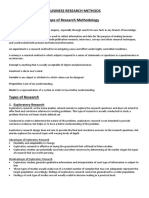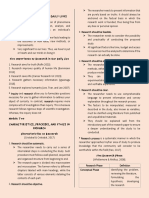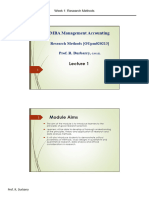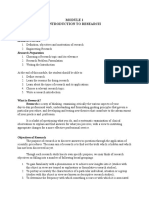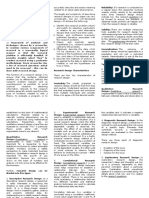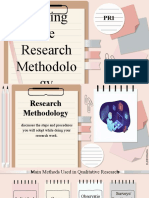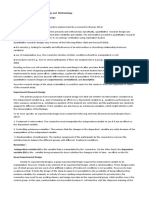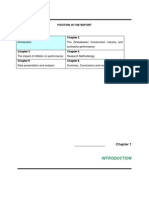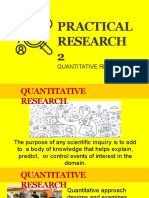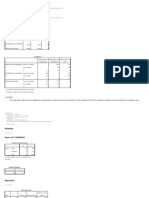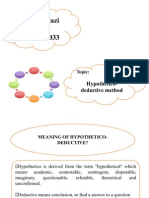Lesson 6: Methodology: First Semester - Academic Year 2024 - 2025 - Prof. Wilbert C. Venzon, LPT, Mba
Lesson 6: Methodology: First Semester - Academic Year 2024 - 2025 - Prof. Wilbert C. Venzon, LPT, Mba
Uploaded by
Jezrael PawilCopyright:
Available Formats
Lesson 6: Methodology: First Semester - Academic Year 2024 - 2025 - Prof. Wilbert C. Venzon, LPT, Mba
Lesson 6: Methodology: First Semester - Academic Year 2024 - 2025 - Prof. Wilbert C. Venzon, LPT, Mba
Uploaded by
Jezrael PawilOriginal Title
Copyright
Available Formats
Share this document
Did you find this document useful?
Is this content inappropriate?
Copyright:
Available Formats
Lesson 6: Methodology: First Semester - Academic Year 2024 - 2025 - Prof. Wilbert C. Venzon, LPT, Mba
Lesson 6: Methodology: First Semester - Academic Year 2024 - 2025 - Prof. Wilbert C. Venzon, LPT, Mba
Uploaded by
Jezrael PawilCopyright:
Available Formats
LESSON 6: METHODOLOGY BUSIRES
FIRST SEMESTER | ACADEMIC YEAR 2024 - 2025| PROF. WILBERT C. VENZON, LPT, MBA.
WHAT IS A RESEARCH METHODOLOGY 2. It should explain the research method and technique to
● Research methodology is a detailed outline of how an be used for the collection and analysis of data.
investigation will take place. 3. It must explain the approach to be implemented in the
● It will typically include how data is to be collected, what processing and analysis of data.
instruments will be employed, how the instruments will
be used, and the intended means for analyzing data PARTS OF A RESEARCH DESIGN
collected. 1. Purpose/Objectives: Clearly state the research
objectives, which can be:
WHAT IS INCLUDED IN THE RESEARCH METHODOLOGY 1.1 Exploratory Research: To explore new topics or
1. Research Design issues with limited prior research.
2. Sampling Plan
3. Research Instrument 1.2 Descriptive Research: To describe concepts and
4. Statistical Treatment Of Data variables related to the topic.
1.3 Explanatory Research: To explain causes and
RESEARCH DESIGN
reasons behind problems or behaviors.
● refers to the action plan and research procedures
developed by the researcher in order to successfully
2. Nature of the Study: Identify whether the study is causal
answer the research problem.
(understanding causes) or correlational (examining
relationships between variables).
FACTORS TO CONSIDER WHEN CHOOSING A RESEARCH
DESIGN
3. Researcher Involvement: Discuss the extent of the
1. Research Questions and Objectives
researcher’s interference with the variables, including
● What is the research problem?
any adjustments made during the study.
● What is the purpose of the study?
● What are the objectives of the research?
4. Setting: Explain whether the research will take place in a
2. Readers
natural or contrived setting, especially in causal studies
● Who are the intended readers of the study? where the environment may be controlled.
● Who are the beneficiaries of the study?
3. Geographical Location and Distribution of the 5. Unit of Analysis: Specify the population or subjects to be
Population Under Study observed, which can range from individuals to groups or
● Where is the geographical focus of the study? organizations.
● Where is the study to be undertaken?
● Who are the people or groups of people under 6. Time Dimension: Define the time frame of the study,
study? indicating if it will be cross-sectional (one-time snapshot)
4. Personal Experiences, Time, and Financial Resources or longitudinal (multiple time points) with types
● How do factors like personal experiences, time, and including time series, panel, and cohort studies.
financial resources affect the research process and
outcome? 7. Data Collection Method: Clearly outline the
5. The Methodology (qualitative, quantitative, or mixed methodology to be used, whether quantitative or
methods) qualitative.
● Is the research qualitative or quantitative?
● What is the most appropriate qualitative or 8. Sampling Method: Explain the sampling technique that
quantitative research method that will be used in will be employed in the research.
the research? Why do you think so?
TYPES OF RESEARCH DESIGN
ELEMENTS OF A RESEARCH DESIGN 1. Quantitative Research Design – the process of
collecting and analyzing numerical data. Which focuses
1. A good research design must have a well-defined and
on numbers, statistics, and relationships between
clearly stated research problem.
variables.
BUSINESS RESEARCH LESSON 6: METHODOLOGY 1
BUSINESS RESEARCH
2. Qualitative Research Design – research design is TYPES OF QUALITATIVE RESEARCH DESIGN
determined by the form or kinds of data, the ways of 1. NARRATIVE RESEARCH
collecting and organizing data, and the procedures for ● studies a single person or several individuals,
analyzing data. gathers data through the collection of stories or
anecdotes, reports the person’s or individual’s
TYPES OF QUANTITATIVE RESEARCH DESIGNS experiences, and discusses the meaning of those
1. EXPERIMENTAL RESEARCH DESIGN – bases its research experiences.
method on a scientific activity called “experiment,” in ● Narrative research comes in several forms, such as:
which a test or examination of a thing under a a. Autobiography – the narrative centers on the
manipulated or controlled environment is done to researcher who is the subject of the study.
determine its validity or truthfulness. b. Biography – a written account of a person’s
● True Experimental Design – It is a biased free life, usually an important personality, often
selection that ensures objectivity of results. The best chronicling that person’s contributions to
way to examine causal relationships. society.
● Quasi-Experimental Design – A research with the c. Life History – provides a more detailed account
capacity to yield findings that are seemingly or more of the subject’s life. As a narrative approach,
or less true. This is more prone to bias rather than life history has its roots in anthropology and
the true experimental design. sociology and chronicles the subject’s history
a. Matched Comparison Group Design – A set of from childhood to adolescence to adulthood,
participants that shows close similarities with taking into account the historical (social,
the experimental treatment group based on political, and economic) contexts in which the
one or more important variables. subject grew up.
b. Time-Series Quasi-Experimental Design – This d. Personal Experience – zeroes in on episodic
is where we compare the pattern of change experiences, whether single or multiple, found
over time to see the connection between the in private situations or shared within a
pre-test and post-test based on the treatment. community.
c. Counterbalanced Quasi-Experimental Design 2. PHENOMENOLOGY
– Control is applied to one group to examine ● describes the “subjective reality” of an event, as
the effects of all treatment and conditions to perceived by the study of a population. The term
control variables. “phenomenology” literally means the study of a
d. Single-Subject Quasi-Experimental Design – A phenomenon (pl. phenomena). A phenomenon is
design that can be applied when a number of any situation, event, concept, or fact that is
individuals are considered as a one group. observed but is unusual or difficult to explain.
● to examine and describe human experiences
2. NON-EXPERIMENTAL RESEARCH DESIGN – This is where through data collected from several individuals who
the researcher cannot control, manipulate the variables undergo the same phenomenon. The goal,
or the subjects. This relies on interpretation, observation therefore, of any phenomenological study is to
or interactions to come to a conclusion. describe the “universal essence” of experiences
a. Descriptive – Portrays an image or a picture of an shared by several people for the rest to understand.
individual or a group. ● For the researchers to avoid biases, they need to
b. Comparative – States the differences and similarities “bracket.”
(e.g. people, things, objects, etc). ○ Bracketing – the process where you need to
c. Correlative – Shows the extent and direction of set aside your own feelings and beliefs about
variable relationships, that is, whether a negative or the phenomenon to produce a balanced and
positive relationship exists between or among them. free observation, analysis, and interpretation.
d. Survey – Describes the attitudes, preferences, views, 3. GROUNDED THEORY
feelings, opinions, and other behavioral patterns of a ● one of the most common but complex types of
big number of people for arriving at a certain qualitative research mostly applied in the field of
conclusion about societal concerns and issues. social sciences.
e. Ex Post Facto – Has the purpose of deriving data ● kind of qualitative research that aims to discover a
from things that are by nature taking place, so as to theory that is grounded in data. It is used when little
obtain explanations about past events. is known about the topic and intends to explore
what is “out there.”
BUSINESS RESEARCH LESSON 6: METHODOLOGY 2
BUSINESS RESEARCH
● This type of research “discovers” a theory from 3. Honesty and Accuracy
existing events or processes that do not have a 4. Responsiveness
predetermined theory. 5. Diversity
● Steps in data gathering for this research include a 6. Reliability
series of coding called open coding, axial coding,
and selective coding. CRITERIA FOR CHOOSING RESPONDENTS
○ Open Coding – From the collected data, 1. KNOWLEDGEABLE PARTICIPANTS – ensure that
researchers need to define, name, or describe respondents have a sufficient understanding of the
basic themes; a process where researchers subject or case being studied
break down sentences and paragraphs to 2. AVAILABILITY WITHIN THE SET TIMEFRAME –
answer questions like “What is this about?” or respondents must be able to provide feedback within the
“What is being referenced here?” given timeframe
○ Axial Coding – researchers find connections or
relationships to the categories. Here, it is CHARACTERISTICS OF RESPONDENTS
noteworthy to find causal conditions, action
● Respondents are selected based on specific criteria
strategies, and consequences.
relevant to the study
○ Selective Coding – used to synthesize and
● Their characteristics, such as demographics (e.g., age,
choose a core category and relate all other
gender, education level), occupation, or behavioral traits,
○ categories to that category to form a unifying
help define the scope of the study.
and emergent theory. The theory created is
● These characteristics must align with the research
also self-correcting, as the data are gathered
objectives to ensure that the findings accurately
and analyzed, adjustments are made to allow
represent the intended population.
for interpretation of new data.
4. ETHNOGRAPHIC RESEARCH DESIGN OR
ROLE IN THE STUDY
ETHNOMETHODOLOGY
● The respondents' primary role is to provide firsthand
● the study of the “entire cultural group”
data, which can be in the form of opinions, experiences,
● analyzes the shared pattern of behaviors, beliefs,
behaviors, or knowledge.
and languages among participants. It aims to
● Their participation is integral to generating insights that
describe and identify the cultural characteristics of a
will answer the study's research questions or
particular group to understand their political, social,
hypotheses.
religious, or psychological processes.
5. CASE STUDY
RESPONDENT BIAS
● explains in detail information about either a person
1. SOCIAL DESIRABILITY BIAS – When respondents give
or group regarding a specific phenomenon in
answers they believe are more socially acceptable or
real-life contexts (e.g., autism, fare-hike, puberty,
favorable, rather than truthful.
managing funds) and draws conclusions only about
2. ACQUIESCENCE BIAS – A tendency to agree with
that individual or group and only in that particular
statements or questions, regardless of actual opinions.
context.
Addressing these biases, either through careful question
● Emphasis is on explanation and description of the
design or using multiple data sources, is essential to
real-life context; why it happened; when it
enhance the reliability of the research.
happened. The goal of the case study approach is to
offer new perspectives or solutions and questions
ENGAGEMENT AND MOTIVATION
for further research.
● Motivating respondents to participate fully and
thoughtfully is vital for gathering quality data.
RESPONDENTS
Respondents who feel that their input is valued and
● Pertains to important individuals who participate by understand the significance of their role are more likely
answering or completing questionnaires, surveys, to provide accurate and complete responses.
interviews and/or other data collection methods ● Clear communication about the purpose and importance
of their contributions can help in maintaining high
SELECTING RESPONDENTS engagement levels.
1. Willingness
2. Relevant Knowledge and Experience
BUSINESS RESEARCH LESSON 6: METHODOLOGY 3
BUSINESS RESEARCH
DIVERSITY OF RESPONDENTS TYPES OF NON-PROBABILITY SAMPLING
● A diverse set of respondents ensures that the study 1. Purposive sampling – refers to intentionally selecting
covers a wide range of perspectives, leading to more participants based on their characteristics, knowledge,
generalizable and comprehensive findings. Depending on experiences, or some other criteria.
the research goals, diversity in terms of demographic 2. Convenience sampling – involves recruiting individuals
backgrounds, professions, and experiences may be primarily because they are available, willing, or easy to
necessary to avoid narrow or biased conclusions. access or contact on a practical level.
3. Snowball Sampling – Existing participants recruit further
SAMPLING AND SAMPLE SIZE participants from among their acquaintances. It is often
used for hard-to-reach or specialized populations.
WHAT IS SAMPLING
● Sampling involves selecting individuals or sampling units
SAMPLING COMPUTATION
from a predetermined sample frame. It is important to
define the sampling strategy beforehand, as the chosen TERMS
method can influence the estimation of the required ● Margin of Error: The margin of error is the range
sample size. that shows how much the results of a survey might
differ from the actual values in the population.
SAMPLE FRAME ● Confidence Level: The confidence level is the
● A sample frame is the group of individuals that can be percentage that tells us how sure we are that the
selected from the target population given the sampling true value is within the range of results from a
process used in the study. survey or study.
TWO TYPES OF SAMPLING SLOVIN’S FORMULA
1. PROBABILITY SAMPLING/RANDOM SAMPLING ● used to determine the sample size needed to attain a
● is a technique for selecting a sample of observations specific confidence interval when sampling a population.
from a population to make assumptions about that This formula is particularly useful when there is
population. If the purpose of sampling is to generalize insufficient information about the population's behavior
the results across the population, use random sampling. or distribution to accurately estimate the required
sample size.
TYPES OF PROBABILITY/RANDOM SAMPLING 𝑁
1. Simple Random Sampling – In this sampling method, 𝑛 = 2
every item in the population has an equal chance of
being chosen for the sample.
1 + 𝑁𝑒
2. Stratified Random Sampling – If the target population WHERE:
has a natural grouping and some groups may have more n = sample size needed
respondents than the other groups, then the right N = Population size
random sampling approach is to stratify the sample e = acceptable margin of error
based on the population distribution.
3. Clustered Sampling – Cluster sampling resembles
stratified sampling; however, the population is divided
into numerous subgroups. A random selection of these
clusters is then made, from which simple random
samples are collected. These subgroups are referred to
as clusters.
4. Systematic Random Sampling – This sampling method
involves selecting samples according to a set interval
from a numbered population.
2. NON-PROBABILITY SAMPLING
● is a technique for selecting units from a population using
a subjective (i.e., non-random) approach. If the purpose
is to target a specific population and not to generalize it
across the population, use purposive sampling.
BUSINESS RESEARCH LESSON 6: METHODOLOGY 4
BUSINESS RESEARCH
COCHRAN’S FORMULA 2. How do I determine the right sample size for my study?
● considered especially appropriate in situations with large ● The appropriate sample size can be determined
populations. A sample of any given size provides more using formulas that consider the desired confidence
information about a smaller population than a larger level, margin of error, population size, and estimated
one, so there’s a ‘correction’ through which the number population proportion.
given by Cochran’s formula can be reduced if the whole
population is relatively small. 3. When should I use a larger or smaller sample size?
2 ● A larger sample size should be used when you want
𝑍 𝑝𝑞
𝑛0 = 2
greater accuracy in your results when dealing with a
highly variable population, or when the margin of
𝑒 error needs to be small. A smaller sample size may
be acceptable for exploratory research or when
resources are limited, but it can lead to less reliable
results and a larger margin of error.
WHERE: RESEARCH INSTRUMENT
e = the desired level of precision (i.e. the margin of error) ● A research instrument is any tool that researchers use to
p = the (estimated) proportion of the population that has the gather data for their study. It can include surveys,
attribute in question questionnaires, interviews, or other devices that help
q=1–p collect information from research subjects.
Z-value = is found in a Z table ● The type of instrument depends on the study’s goals and
the data needed. For instance, surveys are useful for
collecting quantitative data, while interviews are more
suited for qualitative insights
IMPORTANCE
● they ensure that researchers systematically and
consistently collect data. A well-designed instrument can
help reduce biases, ensure reliability, and improve the
validity of the findings. This is critical in ensuring that the
data collected accurately represents the population
being studied
CHARACTERISTICS OF A GOOD RESEARCH INSTRUMENT
1. RELIABILITY
● Refers to the consistency of a measurement,
specifically how consistently an instrument yields
the same results when used repeatedly under the
same conditions with the same subjects.
● it reflects the repeatability of your measurement. A
measure is deemed reliable if a person’s scores on
the same test administered twice are similar. It's
important to note that reliability is estimated rather
than directly measured. A reliable instrument should
OTHER THINGS TO NOTE produce consistent scores, and its reliability is
1. What is the appropriate sample size? typically assessed using some form of correlation
● As to the appropriate sample size, it depends on the coefficient.
school, the panel of examiners, or the contracted ● can be thought of as consistency. Does the
researcher. It should, however, be 100 or more. The instrument consistently measure what it is intended
problem with a big sample size is the cost and time to measure?
involved: it becomes so expensive and it requires a
much longer period to gather the data.
BUSINESS RESEARCH LESSON 6: METHODOLOGY 5
BUSINESS RESEARCH
2. VALIDITY ● Its purpose is to address a specific topic, in-depth, in
● refers to how well a test measures what it purports a comfortable environment to elicit a wide range of
to measure. For results to be accurately applied and opinions, attitudes, feelings, or perceptions from a
interpreted, it is crucial for a test to be valid. group of individuals who share some common
● Validity is not assessed by a single statistic; rather, it experience relative to the dimension under study.
relies on a body of research that shows the ○ Focus Interview: An emphasis on the
relationship between the test and the behavior it interviewees subjective and personal
aims to measure. responses where the interviewer engages to
● is the extent to which an instrument measures what elicit more information.
it is supposed to measure and performs as it is ○ Focus Group Interview: A group of selected
designed to perform participants are asked about their opinion or
● There are numerous statistical tests and measures to perceptions concerning a particular topic.
assess the validity of quantitative instruments, 3. SURVEYS
which generally involves pilot testing. ● Survey research encompasses any measurement
3. PRACTICABILITY procedures that involve asking questions of
● refers to the feasibility and usability of a process or respondents. The types of surveys can vary on the
method. It describes the quality of being applicable span of time used to conduct the study. They can be
in relation to the objectives that need to be made up of cross-sectional surveys and/or
achieved. longitudinal surveys. Types of questions asked in
4. USABILITY surveys include:
● refers to the ease of administering, scoring, ○ Free-Answer: Also referred to as open-ended
interpreting, and applying a test. It encompasses questions, these include unrestricted, essay, or
factors such as low cost and appropriate design or unguided questions.
construction. ○ Guided Response Type: Recall-type questions
5. MEASURABILITY asking the participant to recall a set of
● means that it should effectively assess the objective categories. Multiple-choice or multiple
that needs to be achieved. response questions.
4. OBSERVATIONS
TYPES OF RESEARCH INSTRUMENT ● (watching what people do) is a type of correlational
(non-experimental) method where researchers
1. INTERVIEWS
observe ongoing behavior.
● The interaction where verbal questions are posed by
○ Structured Observations: Research conducted
an interviewer to elicit verbal responses from an
at a specific place, time, where participants are
interviewee.
observed in a standardized procedure. Rather
● It has been said that while other instruments focus
than writing a detailed description of all
on the surface elements of what is happening,
behaviors observed, researchers code
interviews give the researcher more of an insight
observed behaviors according to a previously
into the meaning and significance of what is
agreed-upon scale.
happening.
○ Naturalistic Observation: The study of the
○ Structured Interview: A formal set of
spontaneous behavior of participants in
questions posed to each interviewee and
natural surroundings. The researcher simply
recorded using a standardized procedure.
records what they see in whatever way they
○ Unstructured Interview: A less formal set of
see it.
questions; the interviewer modifies the
○ Participant Observation: A variation on natural
sequence and wording of questions.
observations where the researcher joins in and
○ Non-Directive Interview: An unguided
becomes part of the group they are studying to
interview, including open-ended questions and
get a deeper insight into their lives.
use of spontaneous engagement.
2. FOCUS GROUPS
● A focus group is a carefully planned and moderated
informal discussion where one person’s ideas
bounce off another’s creating a chain reaction of
informative dialogue.
BUSINESS RESEARCH LESSON 6: METHODOLOGY 6
BUSINESS RESEARCH
STEPS IN FINDING A RESEARCH INSTRUMENT 3. OBTAIN
(IDENTIFY – ASSESS – OBTAIN) ● This can be done in several ways:
1. IDENTIFY 1. Use Existing Instruments: If a valid, reliable
● The first step in finding a research instrument is to instrument already exists, reach out to the
identify what type of data you need to collect based author for permission to use it or check if it’s
on your research objectives. This requires a deep freely available online (e.g., in public databases
understanding of your research problem, key or published studies).
questions, and hypotheses. 2. Modify an Existing Instrument: Sometimes,
● You also need to consider whether you are collecting slight adjustments or translations may be
quantitative or qualitative data, or a combination of needed to fit your specific research context.
both. 3. Create a New Instrument: If no suitable tools
○ Quantitative Instruments: If your research are available, you may need to develop your
involves numerical data, you’ll likely need own instrument. Be sure to pilot test it for
structured tools like surveys, questionnaires, or reliability and validity before using it in your
standardized tests. main study.
○ Qualitative Instruments: For qualitative ● Pilot Testing – A pilot test is an initial test
research, instruments like interviews, focus or a miniature version of a larger-scale
groups, or observational tools are more study or project. The term "pilot" means
appropriate. to test a plan, project, or other strategy
before implementing it more fully across
Questions to ask yourself before you begin: an organization
1. How much time do you have?
- Not all instrument's are readily available or ETHICAL CONSIDERATIONS
easy to obtain WHAT IS RESEARCH ETHICS
2. What is your budget? ● Research ethics is about doing research the right way
- Not all instruments are freely available. ● It helps protect the people involved, the researchers, and
the trust in science.
3. What is the instrument's reliability and validity?
- Does the instrument measure what it is
KEY ETHICAL PRINCIPLES
intended to, and does it measure it
consistently? 1. Respect for People – Recognize that everyone has the
right to make their own choices and give informed
4. Will the instrument be available for your use?
consent.
- Even if it’s free, it might be difficult or take too long
2. Doing Good – Aim to provide benefits while reducing any
to get a copy!
harm.
- You need to obtain the owner’s permission,
3. Fairness – Ensure that everyone shares in the benefits
particularly if you want to publish your results
and risks of research.
2. ASSESS
INFORMED CONSENT
● Assess potential instruments based on their
● Informed consent means getting permission from
reliability, validity, and suitability for your target
participants after explaining everything clearly.
population. This involves reviewing available tools
● It should be easy to understand and completely
used in similar studies, conducting a literature
voluntary.
review, and evaluating existing instruments.
● Example: A study on a new medicine where participants
● Key questions to consider during this assessment
know all the details before joining.
include:
1. Has the instrument been validated in previous
KEEPING INFORMATION PRIVATE
studies? (Ensures accuracy in measurement)
2. Is it reliable? (Can it produce consistent ● Protecting personal information is very important.
results?) ● Use methods to keep identities secret.
3. Is it culturally appropriate and ethical?
(Important for sensitive populations or SPECIAL CARE FOR VULNERABLE GROUPS
cross-cultural research) ● Be extra careful with groups like children, prisoners, or
those with less power.
BUSINESS RESEARCH LESSON 6: METHODOLOGY 7
BUSINESS RESEARCH
● Make sure they have extra protections in place. TYPES OF DATA
● Importance of including their voices in research planning. 1. Qualitative Data: Non-numeric data, such as categories
or labels (e.g., gender, profession).
HONESTY IN RESEARCH 2. Quantitative Data: Numeric data that can be measured
● Always be truthful when reporting results. (e.g., height, weight).
● Avoid making up data or copying others' work.
● Example: How false studies can affect public health LEVELS OF MEASUREMENT
decisions. ● Nominal: Categorical data without any order (e.g., types
of cars).
WHAT CAN WE DO TO AVOID THESE ETHICAL PROBLEMS IN ● Ordinal: Categorical data with a specific order (e.g.,
FUTURE RESEARCH rankings).
1. Follow Ethical Guidelines Adhere to established ethical ● Interval: Numeric data with equal intervals, no true zero
principles like honesty, integrity, and respect for point (e.g., temperature).
participants. Familiarize yourself with guidelines from ● Ratio: Numeric data with a true zero point (e.g., age,
organizations like the APA. income).
2. Obtain Informed Consent Ensure participants understand TYPES OF STATISTICAL TREATMENTS
the study's purpose, risks, and their right to withdraw at 1. Descriptive Statistics
any time without penalty. ● Summarizes and organizes data.
● Examples: Mean, median, mode, standard deviation,
3. Conduct Risk Assessments Evaluate potential risks to frequency distribution.
participants and implement measures to minimize harm ● Use: To give a snapshot of the data (e.g., average age
while maximizing benefits. of participants).
2. Inferential Statistics
4. Ensure Fair Participant Selection Avoid biases in selecting
● Helps make inferences or generalizations from the
participants, ensuring inclusivity and fairness regardless
sample to the population.
of gender, race, or background.
● Examples: Hypothesis testing, confidence intervals,
t-tests, ANOVA.
5. Maintain Transparency Be open about your research
● Use: To determine if findings are statistically
methods and any conflicts of interest to build trust and
significant or if they can be generalized.
credibility.
3. Correlation and Regression Analysis
● Correlation: Measures the relationship between two
6. Engage Ethics Review Boards Submit your research
variables.
proposals to ethics committees for review to ensure
● Regression: Predicts the value of one variable based
compliance with ethical standards.
on the value of another.
● Use: To analyze relationships or predict outcomes
STATISTICAL TREATMENT
(e.g., the impact of study hours on grades).
● Statistical treatment in research refers to the process of
4. Non-Parametric Tests
applying statistical methods to analyze and interpret data
● Used when data doesn’t meet the assumptions of
collected during a study. It is crucial because it allows
parametric tests (e.g., normal distribution).
researchers to draw meaningful conclusions and insights
● Examples: Chi-square test, Mann-Whitney U test.
from the data, determine the significance of their
● Use: For ordinal data or non-normally distributed
findings, and test hypotheses.
data (e.g., preference surveys).
KEY CONCEPTS IN STATISTICAL TREATMENT
CHOOSING THE RIGHT STATISTICAL TREATMENT
VARIABLES
1. Identify the Research Type and Data
● Independent Variable: The variable you manipulate in
the study. ● For quantitative research, numerical analysis using
● Dependent Variable: The outcome you measure in descriptive or inferential statistics is common.
response to changes in the independent variable. ● For qualitative research, frequency distributions or
non-parametric tests may be more appropriate.
BUSINESS RESEARCH LESSON 6: METHODOLOGY 8
BUSINESS RESEARCH
2. Determine Data Distribution
● Check if your data is normally distributed. If yes, use
parametric tests. If not, use non-parametric tests.
3. Match Data to Statistical Tests
● Nominal Data: Use frequency distributions or
chi-square tests.
● Ordinal Data: Use rank-based tests like the
Mann-Whitney U test.
● Interval and Ratio Data: Use t-tests, ANOVA, or
regression analysis.
BUSINESS RESEARCH LESSON 6: METHODOLOGY 9
You might also like
- Module I Nature and Scope of Research MethodologyDocument6 pagesModule I Nature and Scope of Research MethodologyKhushbu Saxena100% (2)
- Business Statistics: Fourth Canadian EditionDocument33 pagesBusiness Statistics: Fourth Canadian EditionTaron AhsanNo ratings yet
- BBRS4103 - Marketing ResearchDocument12 pagesBBRS4103 - Marketing ResearchZafei ArsyadNo ratings yet
- Research DesignDocument45 pagesResearch Designsubashik100% (2)
- Research Design Unit 2Document51 pagesResearch Design Unit 2pragyatiwariNo ratings yet
- Chapter 1 Methods of ResearchDocument12 pagesChapter 1 Methods of ResearchKimberly DazoNo ratings yet
- Chapter 1 - Research Methodology - An IntroductionDocument38 pagesChapter 1 - Research Methodology - An IntroductionNguyễn Khánh MyNo ratings yet
- PR 1 ReviewerDocument7 pagesPR 1 ReviewerJAMES GAMERNo ratings yet
- Para Makagraduate Ft. ResearchDocument12 pagesPara Makagraduate Ft. ResearchsheriNo ratings yet
- Methodology and Design For Qualitative ResearchDocument4 pagesMethodology and Design For Qualitative ResearchJillian Blesille GarciaNo ratings yet
- Research Methodology: Subject Code: 18MTP15Document25 pagesResearch Methodology: Subject Code: 18MTP15Ganesh T NaikNo ratings yet
- Research MethodsDocument3 pagesResearch MethodsBea Dela PeñaNo ratings yet
- Research Basic ConceptsDocument22 pagesResearch Basic ConceptsRodNo ratings yet
- Approaches To ResearchDocument18 pagesApproaches To ResearchDanushri BalamuruganNo ratings yet
- Mor 1 ReviewerDocument3 pagesMor 1 ReviewerNicole Deione MorcillaNo ratings yet
- Module 5 Res 3Document117 pagesModule 5 Res 3marcleeisgNo ratings yet
- Types and Designs of ResearchDocument49 pagesTypes and Designs of Researchgon MacknoNo ratings yet
- Research NewDocument55 pagesResearch Newbienvenufabrice2001No ratings yet
- Survey Questions and AnswersDocument11 pagesSurvey Questions and AnswersBrima MorrayNo ratings yet
- Unit 2 RM Research Methodology BbaDocument26 pagesUnit 2 RM Research Methodology BbaPraduman SharmaNo ratings yet
- Practical Research I: Qualitative Research Reviewer: Free Online Database SamplesDocument3 pagesPractical Research I: Qualitative Research Reviewer: Free Online Database SamplesElenear De OcampoNo ratings yet
- Caps 11 - 12 Q2 0501 FDDocument24 pagesCaps 11 - 12 Q2 0501 FDUbertreffen SolilapsiNo ratings yet
- Seminar I SlidesDocument104 pagesSeminar I Slidesadilyar2002No ratings yet
- Introduction To Psychological Research: Aakanksha Verma Group 1 Shaheed Rajguru College of Applied Sciences For WomenDocument18 pagesIntroduction To Psychological Research: Aakanksha Verma Group 1 Shaheed Rajguru College of Applied Sciences For WomenAakanksha VermaNo ratings yet
- Research MethodologyDocument6 pagesResearch Methodologygoldyanna6No ratings yet
- Research MethodologyDocument73 pagesResearch MethodologyDawaNo ratings yet
- RDL ReviewerDocument10 pagesRDL ReviewerGweneth WajeNo ratings yet
- Research Methodology AssignmentDocument23 pagesResearch Methodology Assignmentbcda8117No ratings yet
- Midterm Reviewer - (101623)Document5 pagesMidterm Reviewer - (101623)Denver Ashley ManabatNo ratings yet
- Research DesignDocument12 pagesResearch DesigncharuNo ratings yet
- 1.introduction To Research MethodologyDocument37 pages1.introduction To Research MethodologyVinita bajajNo ratings yet
- Session 1Document23 pagesSession 1Roshan DhotahNo ratings yet
- Qualitative Research Designs Case StudyDocument34 pagesQualitative Research Designs Case StudyaizuNo ratings yet
- Steps in Research ProcessDocument8 pagesSteps in Research ProcessSkye M. PetersNo ratings yet
- Introduction To Research MethodologyDocument26 pagesIntroduction To Research MethodologySUSAN PETER TERUNo ratings yet
- Q1 PR2 Notes 2Document14 pagesQ1 PR2 Notes 2ericka khimNo ratings yet
- Research Design PP TDocument77 pagesResearch Design PP TTirumala RaoNo ratings yet
- Week 1 - Lecture - 2nd March. 2021 - Intro-Course Overview (Adapted - Mwinuan)Document27 pagesWeek 1 - Lecture - 2nd March. 2021 - Intro-Course Overview (Adapted - Mwinuan)Israel PopeNo ratings yet
- Research ReviewerDocument9 pagesResearch ReviewerEvalyn M. SalvaNo ratings yet
- NCM 111 Research 1 Midterm by Xerxes G. Malaga, RN, MNDocument14 pagesNCM 111 Research 1 Midterm by Xerxes G. Malaga, RN, MNczeremar chanNo ratings yet
- AGRICDocument3 pagesAGRIClayla landNo ratings yet
- ZOO 3204 A 01. IntroductionDocument8 pagesZOO 3204 A 01. Introductiononline3275No ratings yet
- Introduction to Research101Document68 pagesIntroduction to Research101jasminenicoleyapNo ratings yet
- RM, Chapter 1Document29 pagesRM, Chapter 1Yitera SisayNo ratings yet
- Unit 1Document80 pagesUnit 1Game ZoneNo ratings yet
- Research MethodDocument8 pagesResearch MethodEyuelNo ratings yet
- Moodule Notes - Methods of social research 1 - Sept - Dec 2024 - Tharaka - SharingDocument48 pagesMoodule Notes - Methods of social research 1 - Sept - Dec 2024 - Tharaka - Sharingnaekumirriam3No ratings yet
- Unit-I BRMDocument16 pagesUnit-I BRMTamil piratesNo ratings yet
- Business Research Method All in OneDocument71 pagesBusiness Research Method All in Onebibeek.1029No ratings yet
- Research MethodsDocument245 pagesResearch MethodsKathleen Castillo100% (1)
- 18MBA23 Research Methods Full Notes With Question BankDocument87 pages18MBA23 Research Methods Full Notes With Question BankNeena86% (7)
- The Hashemite University Research MethodologyDocument46 pagesThe Hashemite University Research MethodologyIbrahim ObeidatNo ratings yet
- Unit 4 Research DesignDocument20 pagesUnit 4 Research Designgosaye desalegn100% (1)
- Research MethodologyDocument45 pagesResearch MethodologyRishabhDevNo ratings yet
- Research DesignDocument11 pagesResearch DesignAivannah Marie LopenaNo ratings yet
- Writing The Research Methodolo GyDocument17 pagesWriting The Research Methodolo GyAibie AlmoradoNo ratings yet
- Research 1Document14 pagesResearch 1Alemu BelayNo ratings yet
- Practical Research 1 ReviewerDocument13 pagesPractical Research 1 Reviewerjamifatie21No ratings yet
- Ilovepdf MergedDocument14 pagesIlovepdf Merged333zett333No ratings yet
- Unit 1 ResearchDocument5 pagesUnit 1 ResearchSarvesh ShahNo ratings yet
- Proiect Final EconometrieDocument6 pagesProiect Final EconometrieAmalia SirbuNo ratings yet
- RationaleDocument2 pagesRationalecielNo ratings yet
- Experimental MethodDocument7 pagesExperimental MethodpravinnahelanmaryNo ratings yet
- Reviewer in RDL2Document6 pagesReviewer in RDL2sevirous valeriaNo ratings yet
- Lampiran 1. Surat Permohonan Kesediaan Menjadi Subjek PenelitianDocument9 pagesLampiran 1. Surat Permohonan Kesediaan Menjadi Subjek PenelitianNanda SusiloNo ratings yet
- Final Exams Edad 202 StatDocument3 pagesFinal Exams Edad 202 StatGERRYNo ratings yet
- Ange PR Ans 2Document2 pagesAnge PR Ans 2Angelica RamosNo ratings yet
- MATH1041 Final Cheat SheetDocument3 pagesMATH1041 Final Cheat SheetBasil RaziNo ratings yet
- AE114 Topic 1 Module 2Document4 pagesAE114 Topic 1 Module 2Jane PadillaNo ratings yet
- The Effects of Hyper Inflation On Contractor Performance A Case StudyDocument6 pagesThe Effects of Hyper Inflation On Contractor Performance A Case StudyNelson PayendaNo ratings yet
- Research Design: - Framework/Blueprint For Research Plan of - Specifies The Details. - Components (Specification Of)Document40 pagesResearch Design: - Framework/Blueprint For Research Plan of - Specifies The Details. - Components (Specification Of)Priyanka Jain100% (1)
- Correlation DesignDocument5 pagesCorrelation DesignBernadeth TenorioNo ratings yet
- Assumptions of MANOVADocument2 pagesAssumptions of MANOVAfirstnamezaplan100% (1)
- ST130: Basic Statistics: Duration of Exam: 3 Hours + 10 MinutesDocument12 pagesST130: Basic Statistics: Duration of Exam: 3 Hours + 10 MinutesChand DivneshNo ratings yet
- Lesson 1 - Quatitative ResearchDocument39 pagesLesson 1 - Quatitative ResearchGian Jane QuiñonesNo ratings yet
- Research On Management PDFDocument64 pagesResearch On Management PDFPramodNo ratings yet
- GM07 Both AssignmentsDocument9 pagesGM07 Both AssignmentsA Kaur MarwahNo ratings yet
- Uts Bahrudin SungeDocument15 pagesUts Bahrudin SungeAnonymous 7Hi4EroNo ratings yet
- RPP bwm22502 Sem1 - 18 - 19Document6 pagesRPP bwm22502 Sem1 - 18 - 19muhd aziq fikri mohd raziNo ratings yet
- Ch. 9 Lecture Slides Fall 2018Document77 pagesCh. 9 Lecture Slides Fall 2018Gajan NagarajNo ratings yet
- Hypothetico Deductive MethodDocument27 pagesHypothetico Deductive MethodUsman AzizNo ratings yet
- Business Research - MethodologyDocument10 pagesBusiness Research - MethodologysokrisbaNo ratings yet
- Writing Strategies and Ethical ConsiderationsDocument28 pagesWriting Strategies and Ethical ConsiderationsKim Wenceslao SanchezNo ratings yet
- Week003-Levels of Measurement: Laboratory Exercise 001Document3 pagesWeek003-Levels of Measurement: Laboratory Exercise 001jymrprzbtstNo ratings yet
- Chapter IIIDocument3 pagesChapter IIIjakatoniNo ratings yet
- Chapter 11: Chi-Square and ANOVA TestsDocument40 pagesChapter 11: Chi-Square and ANOVA TestsmatharajeshNo ratings yet
- 577 525 1 PB PDFDocument15 pages577 525 1 PB PDFKhanza malahaNo ratings yet

